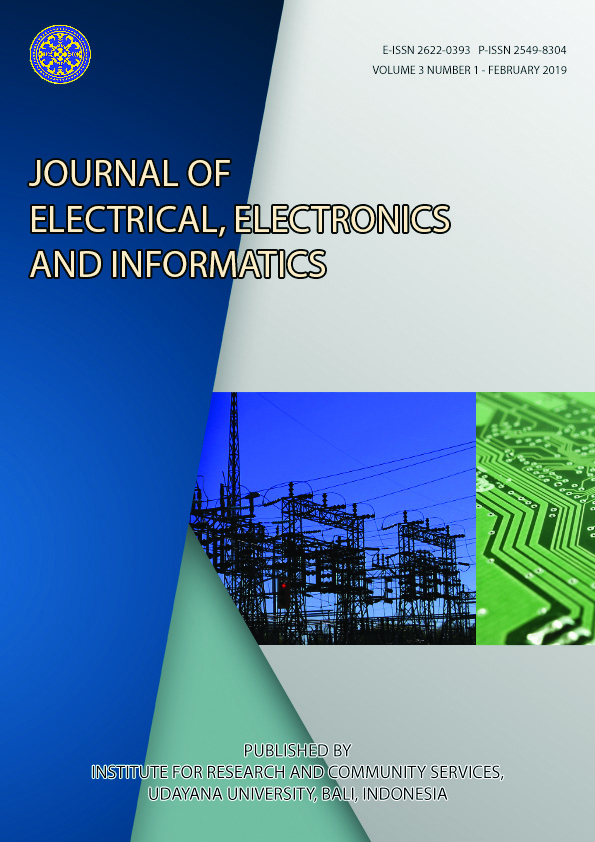Performance Analysis of MIMO STBC System in Flat Fading and Frequency Selective Fading Channels
Abstract
Multiple Input Multiple Output (MIMO) technology is a technique that can be used to overcome multipath fading. The multipath fading is caused by signals coming from several paths that experience different attenuations, delays and phases. In a multipath condition, an impulse that sent by the transmitter, will be received by the recipient not as an impulse but as a pulse with a spread width that called delay spread. Delay spread can cause intersymbol interference (ISI) and bit translation errors from the information received. To determine the effect of delay spread on the MIMO system, then MIMO system performance research was performed on flat fading and frequency selective fading channels using the Space Time Block Code (STBC) coding technique. This research was conducted using MatLab 2018a software. The simulation results show that the MIMO STBC system performance on flat fading channels is better than the MIMO STBC system performance on the frequency selective fading channel. This result is analyzed based on the value of BER vs. Eb/No and eye diagram.
Downloads
References
[2] Maddanaca, A. (2012). Reduksi Peak-To-Average Power Ratio Pada Sistem STBC MIMO-OFDM dengan Metode Selected Mapping dan Partial Transmit Sequence. IncomTech Journal of Telecommunications and Computers, Vol.3, no.1.
[3] Hen, I. (2006). MIMO Architecture for Wireless Communication. In Intel Technology Journal, vol. 10, issue 02.
[4] Purwanto, T.B. (2015). Analisis Unjuk Kerja Teknik MIMO STBC dan V-BLAST Pada Sistem Orthogonal Frequency Division Multiplexing. SPEKTRUM Journal, vol.2, no. 2.
[5] Wardhana, L & Makodian, N. 2010. Teknologi Wireless Communication dan Wireless Broadband. Yogyakarta: Andi Offset.
[6] Alamouti, S.M. (1998). A Simple Transmit Diversity Technique for Wireless Communication. IEEE Journal On Selected Areas in Communication, vol. 16, no. 8, pp. 1451-1458, Oct 1998.
[7] Prabowo, W.E., et al. (2014). Pengaruh Multipath Fading Terhadap Performansi Pada Downlink Jaringan CDMA2000 1X EV-DO Revision A. TEUB College Student Journal, vol. 2, no.3.
[8] Rappaport, T.S. 1996. Wireless Communication Principle and Practice. New Jersey: Prentice Hall.
[9] Cho, Y.S., et al. 2010. MIMO-OFDM Wireless Communication with MatLab. New York: John Wiley & Sons.
[10] Fazel, K. & Kaiser, S. 2008. Multi-Carrier and Spread Spectrum System from OFDM and MC-CDMA to LTE and WiMAX, Second Edition. New York: John Wiley & Sons.
[11] Hakim, M. (2017). Analisis Variasi Jumlah Antena Terhadap Unjuk Kerja Sistem Orthogonal Frequency Division Multiplexing MIMO (Thesis). Denpasar: Udayana University.
[12] Seams, J. (2005). A Comparison of Resistive Terminators for High Speed Digital Data Transmission. High Frequency Electronics Journal, vol. 4, No. 10.
[13] Haider, D., et al. (2017). MIMO Network and The Alamouti, STBC (Space Time Block Coding). American Journal of Electrical and Electronic Engineering, vol. 5, No. 1, pp. 23-27.
[14] Jafarkhani, H. 2005. Space Time Coding: Theory and Practice. Cambridge: Cambridge University Press.

This work is licensed under a Creative Commons Attribution-ShareAlike 4.0 International License.











